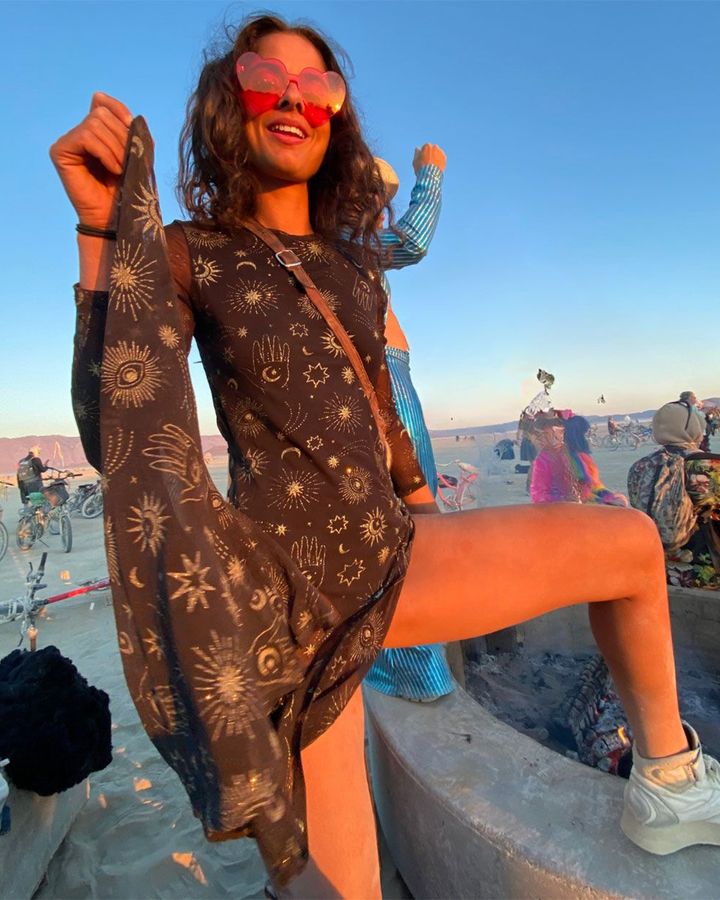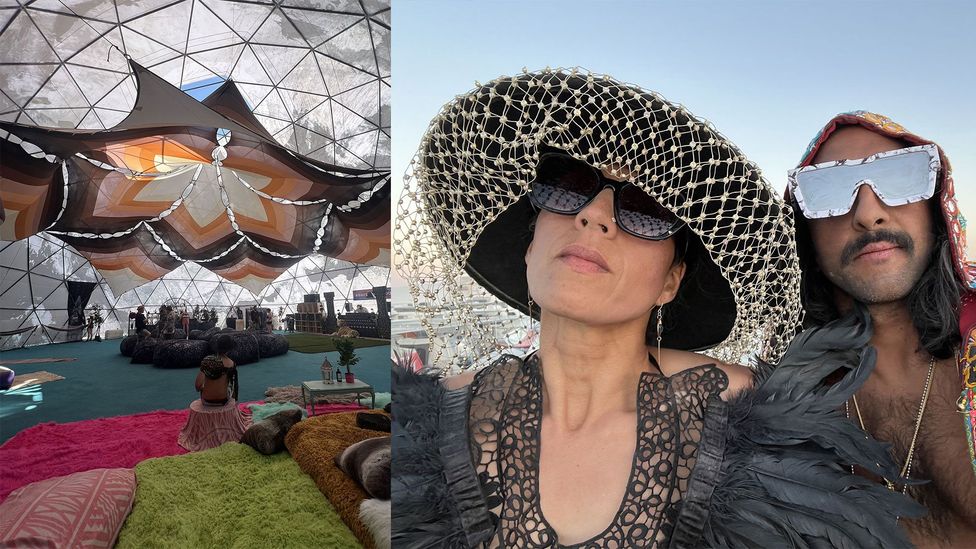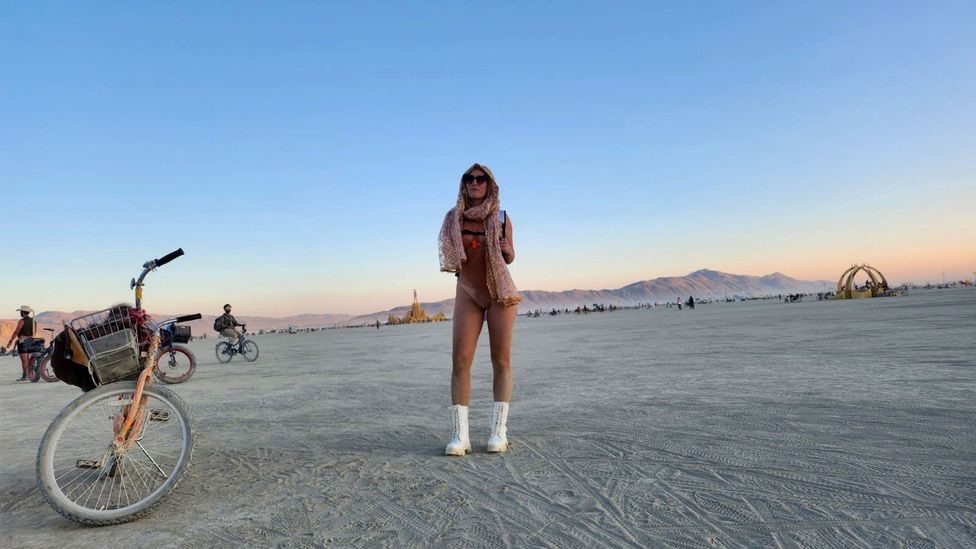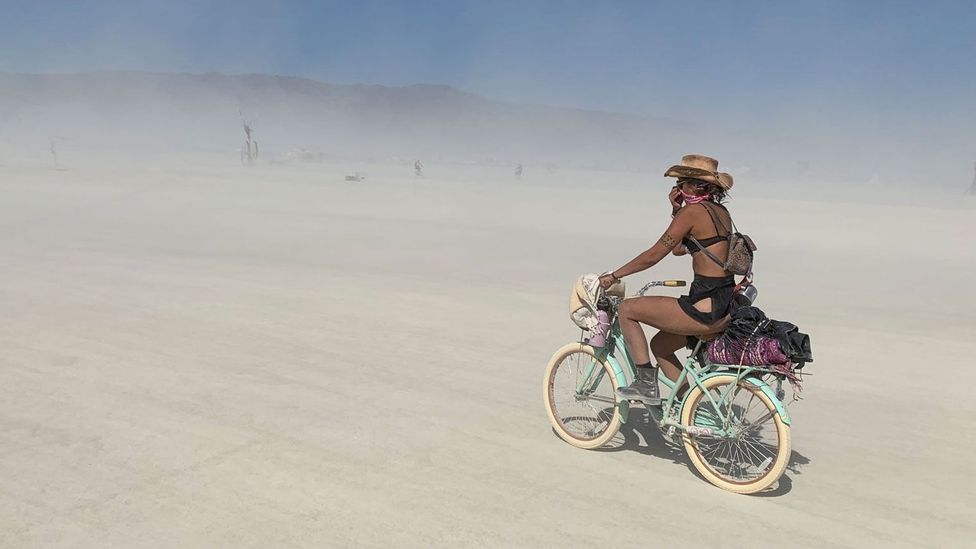It's not easy – or cheap – to pop up a bustling city from empty desert ground. But that's exactly what happens at the Burning Man festival, held annually in Nevada's Black Rock Desert.
Burning Man started in 1986 at a San Francisco beach with 35 people united by "the pursuit of a more creative and connected existence in the world"; this week, nearly 70,000 people are making their way out of the muddy desert after Burning Man's 37th year. The now nine-day festival has morphed into a massive brand and destination, where so-called "Burners" from around the world build a civilisation together from scratch, complete with art installations, healing camps, inspiring talks and live DJs.
Each year, attendees can spend thousands on tickets, dues, transportation and supplies for life on the playa, plus put in unquantifiable labour. Yet many say it's worth every penny.

Tessa Velázquez (Credit: Courtesy of Tessa Velázquez)
Tessa Velázquez, 33: $5,000 to $7,000
Tessa Velázquez has been to Burning Man four times – she even introduced her father to the festival (he's now attended several times, too). The New York-based chef, who makes documentary-style food TikToks, attended her first Burning Man when she was 26. "I heard magical things about the art, the music, the self-discovery, the spiritual journey, and that really enticed me," she says.
Velázquez had never been to a festival – or even spent a night camping – prior to Burning Man, but had heard from peers she was going to "find herself" in the desert. She became a convert, and has since spent $5,000 to $7,000 (£4,010 to £5,520) for each trip to the playa.
Beyond the hidden labour costs, which can include hours of setting up and breaking down camp, for her 2022 trip, Velázquez spent around $1,000 on a round-trip flight from New York City to Reno, Nevada; $700 on a festival ticket ($595, plus fees and shipping) and $500 to get her supplies to the site. She also spent nearly $600 on personal items like costumes; $1,500 on a shared RV (caravan), where she stayed; and $400 on camp dues, which included shared resources of food, water, shade structures and a power generator.
As a self-employed worker without paid vacation days, Velázquez rationed her resources to participate in Burning Man the first few years she attended. It paid off. "I was hoping for awe and wonder, hoping to be inspired, I was hoping to find myself, hoping to have fun and challenge myself," she says, "and that actually all happened."
Yet she hasn't gone back since 2022. The costs are substantial, but Velásquez also says she's disillusioned by "social media influencers and the tech CEO types that don't really adhere to the founding principles of Burning Man", like communal effort, participation, leaving no trace and civic responsibility. She believes she can spend her money better elsewhere, where she isn't damaging the environment or bucking her ethics.

The Agave Lounge and Prem and Penny Kumta (Credit: Courtesy of Prem Kumta)
Prem Kumta, 47: $8,000
San Francisco-based Prem Kumta discovered Burning Man in the early 2000s through friends who were producing a giant sound camp – a town within the city of Burning Man – with a mile-long sonic art installation across the playa.
With an inaugural Burning Man experience in 2003, creative agency CEO Kumta and his wife Penny attended the festival half a dozen times until they had children, returning when their three kids got older. Their most recent trip was 2022.
Unlike many other festivalgoers, Kumta is part of a big camp with a particularly "massive set-up", so the costs can run a little more – he is one of the founders of the Agave Lounge, a camp with more than 150 people and a carpeted and covered geodesic dome, built to protect people from the elements. Inside the dome is an agave-themed bar that gives away 20,000 to 30,000 drinks over the course of the week, a jumpy castle, a gigantic sound system for world-class DJ performances and medical supplies for those in need during extreme weather.
"We have camp dues and run fundraisers to raise enough money for our camp. The dome, sound system, carpeting and decor, generator to power the dome and RVs, showers, shade structures, trucks to bring everything to and from the playa and storage space to keep everything – it is a ton of money, close to six-figures."
For him and his wife, Kumta budgets about $8,000 (£6,400) for the week-plus on the playa. The rough breakdown comes out to $1,500 for two tickets and one parking pass, and $500 in camp dues per person. RVs cost between $4,000 and $9,000, depending on how big they are as well as food, water and supplies for the couple which can run $1,500. Unique outfits, which are encouraged for radical self-expression, can easily also cost $1,500 for two people.
"If you're going to stay at a really nice resort for that long, go shopping, and eat out, it's pretty comparable," he says.
With two decades of experience creating, building and executing site-specific events for globally recognized brands, Kumta believes "there's just nothing in the world even close to Burning Man". He continues, "What I get out of Burning Man is a release from the ever-present pressure to succeed and produce in our modern world … What you spend on the experience you make up in multiples … I've never attended and thought I wasted my money."

Fiona Hillery (Credit: Courtesy of Fiona Hillery)
Fiona Hillery, 33: $1,500
Fiona Hillery had never gone to Burning Man. But her fiancé, a veteran Burner, piqued her interest in the festival. She attended for the first time this year.
"I've always wanted to go, but was never in a financial position to go when I was younger," says Hillery, based in Los Angeles. "Even if you spend the money on a ticket, a lot of people can't take time off work, so this is the first year I have been privileged enough to do that."
She decided to go just two weeks before the festival – she was gifted a discounted ticket for $200, which lowered her barrier for entry.
Hillery flew to Reno from Los Angeles on airline miles for about $600, and for $150 took the Burner Bus, which brings passengers straight to the playa. After joining an established camp of healers, misfits and jesters – she paid $400 in dues – Hillery got her own stash of water for $20, and spent about $200 on warm clothes (she notes she'll likely never wear them again due to sticky playa dust).
In her inaugural trip, Hillery wanted to explore how "stripping away status and money helps you show up in the community". She says, "The mixture of all the things you can get in society are in this city, but you're taking away the commodification part." The experience was complete with inspirational talks about UFOs and psychedelic-assisted mental wellness, sound baths and spontaneous activities like the giant hot air balloon trip she won in a game of musical chairs.
The cost, says Hillery, was worth it.
"The sense of community – before and after the rain – improved my faith in humanity. The kindness of strangers, a sense of shared commonality, interest in art and music and living more freely were inspiring. Burning Man is an open, loving and encouraging society that gave me more confidence. If the apocalypse comes, I'm with the Burners."
